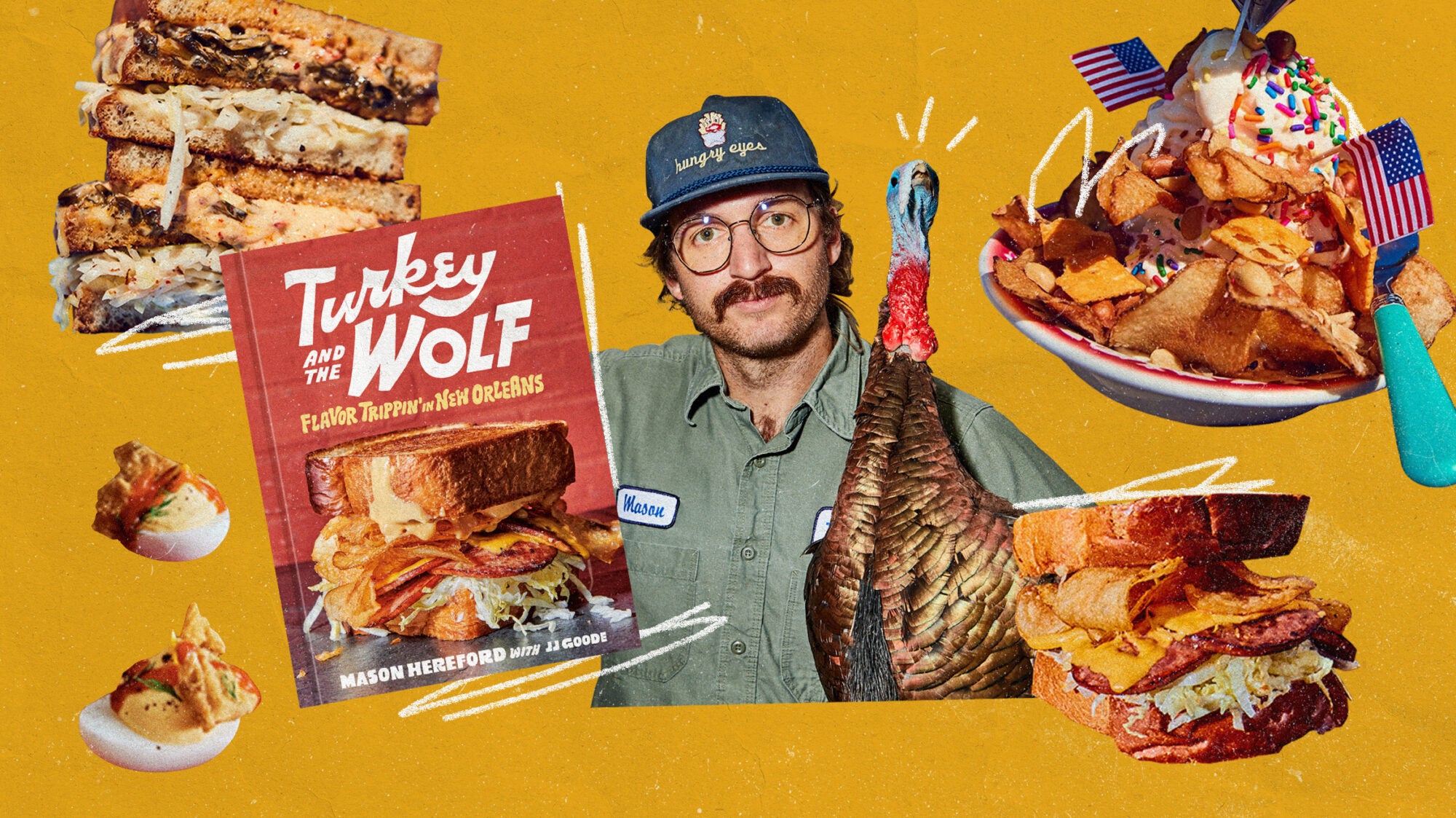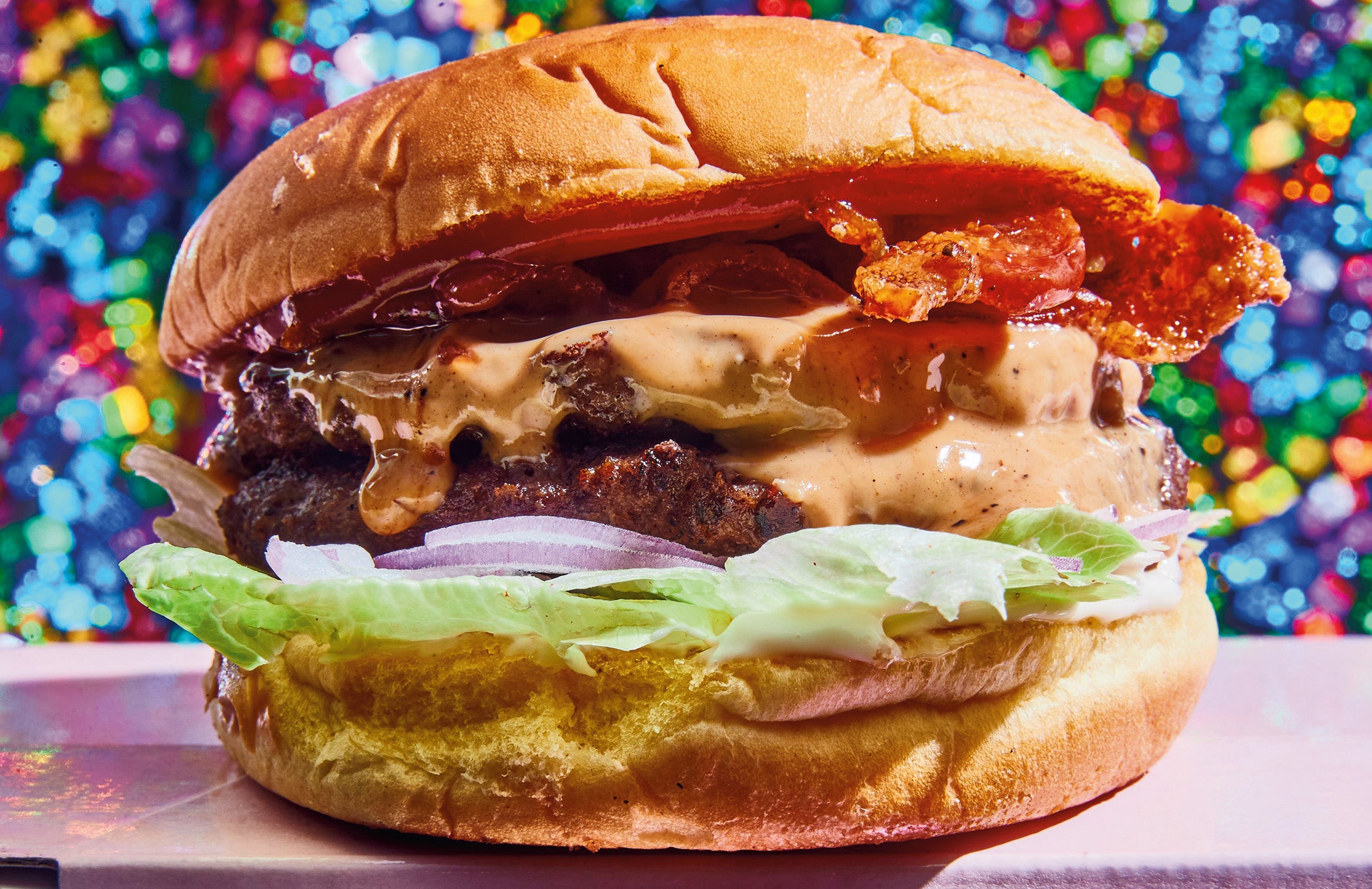
Turkey and the Wolf’s ambitious chef, Mason Hereford, deep fries his feelings.
Mason Hereford might be a famous chef from New Orleans—Food & Wine magazine named his first restaurant, Turkey and the Wolf, one of the most important of the last decade—but he would be the first to tell you that he doesn’t do the old traditional cuisine of that wonderful city. What he does do is nail the city’s spirit, which he loosely defines “as a group of people who exist to have a good time.”
Hereford’s two restaurants—and his brand-new cookbook, Turkey and the Wolf: Flavor Trippin’ in New Orleans—are all undeniably “a good time.” (He opened the daytime sandwich spot Turkey and the Wolf in 2016 and the breakfast joint Molly’s Rise and Shine two years later.) I believe even a teetotaling vegan would enjoy his stories of creating the perfect country fried steak sandwich that was too good to keep on the menu (thanks to the pickles, pepper jelly, slaw, and chicken bouillon powder) or nights spent drinking free shots of “grandma”—Grand Marnier—during his post-collegiate nights working as a New Orleans bartender. (It’s a service industry thing there, he told me, like Jeppson’s Malört in Chicago.)
Hereford, who paid his culinary dues with 15-hour days in one of New Orleans’ respected fine-dining kitchens, Coquette, has long since forged another path, which is indeed both trippy and flavor-blasted. In a recent conversation, we talked about his love of sauces—chimichurri cream cheese and peanut butter salsa macha are among more than two dozen beauties in the book—and the birth of his most famous creation, a fried bologna and American cheese sandwich with two sauces on extra-buttery Texas toast. P.S. Yes, I asked about his blood pressure: it’s all good.
In your introduction, you talk about the first time you put chips on your bologna sandwich as a kid. I was curious whether you realized this was your eureka moment of layering flavors even back then?
I think some people were adding chips to their sandwich as a layer, sort of the way they’re on our sandwich, to create texture or a balance of flavors. Obviously, you’re not thinking that loftily as a child. You’re like, “Oh, I’m gonna put chips on it, to make the sandwich cooler and more fun to eat.” But I was putting the chips on there because it was either that or cry—or gag—as a five-year-old. I distinctly remember being like, “If I don’t put chips on this sandwich, it is not going down. And if I don’t eat the sandwich, I am not getting lunch. So here we go.”
So you don’t think of it as an eureka moment?
Yes and no. I think that maybe the eureka moment was when I was writing the menu for Turkey and the Wolf, and I had a list of things I wanted to try. When I wrote down that sandwich with the chips on it—and a lot of people had this put-the-chips-on-the-sandwich as a kid, I’ve found out since doing it—maybe the eureka moment was then, realizing that it was a really useful tool for making this sandwich better, rather than just seeing it like a kid trying to pass it as a lunchtime possibility.
It seemed, from reading your book, that both your mom and your dad were also perhaps experts at applying condiments for extra flavor.
I’ve just been food-obsessed my whole life, and sauce is the coolest food. Like, there’s nothing better than dip, and dipping and applying sauce to something that needs it. The way a chicken tender or chicken nugget [laughs] or whatever can transform when you dip it into Buffalo sauce or honey mustard or barbecue or whatever? That shit’s all very exciting at a very young age, and maybe chicken tenders or chicken nuggets are one of your first experiences with that.
But if I had to pick one moment, I distinctly remember being at Chili’s and watching my dad take this last bite of food and dipping it in all the fucking shit left over on everybody’s plate. Ketchup was on one person’s plate. And then he saw the honey mustard from somebody’s tendies, and there was some salsa left over from some quesadillas. And he dipped in like eight things, and I was like, “Dad, you’re a fucking wild man. That’s truly wild that you just did that.” That image, that moment, really sticks in my head.
You write about that in the book!
My mom was the cook. My dad—when they were divorced and he had to make food—would give us a smorgasbord of the frozen food aisle from Sam’s Club, which was just as exciting, also because it was less often. But it would be, like, taquitos and a frozen potato skin product and something else. And, you know, that was his big meal for us [laughs]. If I was to say I learned “cooking” from one person, it was maybe from my mom, but it’s not this sort of handed-down, passed-down family traditional thing. For me, it’s kind of just grabbing your cooking style from all the lived experiences in your life—be it from New Orleans, or from being a kid out in the country, or whatever.
Yes, that’s you exactly. As you read your cookbook, like with the Vietnamese cabbage salad inspired by Uncle Boons or using frozen roti paratha, you see that they keep coming too.
They keep coming, man. I learn something every time. I feel like every time I eat out, there’s a light bulb. Even if you’re eating at 7-Eleven, you’re like, “Something about that cheese was a little off, but I think I liked it. What was it that did that?” And then you write it in your phone, and then it either disappears or you revisit it in a meeting with your buddies when you’re trying to figure out your next menu.
3 EXCITING RECIPES FROM TURKEY AND THE WOLF:
A Really Good Wedge
Excess is the key to this salad—a borderline inappropriate amount of blue cheese dressing.
Collard Green Melt
A melty melt with stewed collard greens swapped in for your typical protein of choice. Genius.
Peanut Butter Bacon Burger
If you want comfort, make this burger.
